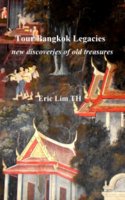| Back to Back Issues Page |
 |
|
Bangkok Travelbug June 14 Bang Pakong River boat tour May 28, 2014 |
| Hello
Bang Pakong River boat tour Our river boat tour of the Bang Pakong started from the Ban Mai Market and took us to Wat Saman Rattanaram, a temple on an island in the river. The journey took about 20 – 25 minutes. We pushed off from the Ban Mai Market pier, proceeded upriver and passed riverside settlements, mangrove, uninhabited stretches of the river banks and even some chalets along the way! Here are some of the river scenes. 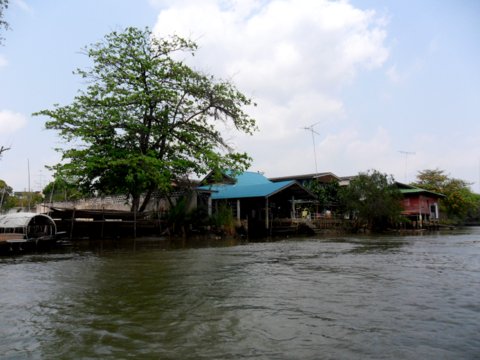


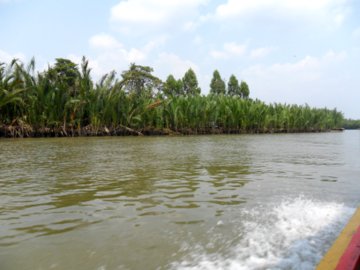

We had to pass under the Bang Pakong Dam through the sluice gates. This dam was built across the new canal that was dug to shorten the course of the Bang Pakong. 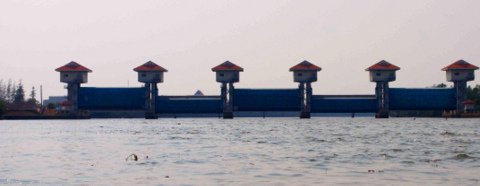
Bang Pakong Dam – courtesy of Lim Siew Hwei The boat turned right to enter the old course of the river and we arrived at Wat Saman Rattanaram. We were left here for an hour and 40 minutes to explore this very unusual temple. Table of contents Wat Saman Rattanaram Wat Saman Rattanaram is located on an island which was recently created when a canal was dug across the base of the sharp meander in the river to shorten the course. Digital maps of the area dated 2008 still show the island as part of the mainland on the west bank of the Bang Pakong. So the canal must have been dug after 2008. The distinctive feature of this temple is the wide variety of deities Buddhism, Hinduism and Taoist present and worshipped by devout followers. The first thing a visitor encounters on approaching the island is an islet attached to the main island by a bridge. The islet is decorated as a giant red lotus flower* with a pedestal in the centre. Visitors can cross over and walk around this islet. 
Lotus Island – courtesy of Lim Siew Hwei *Red lotus flowers signify compassion and love. We walked through the temple grounds and we came across a dais with statues of Buddha in various postures. 
Buddha statues Opposite this dais was a row of monks seated crossed legged with alms bowls in front of them. 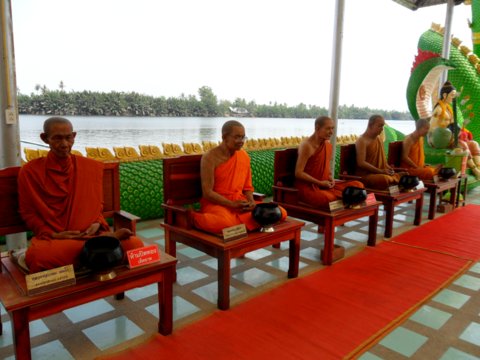
On a closer look I was surprised to find that these were wax figures! I was curious about the next photo as I didn’t know who it was. It took a few enquires to find out. 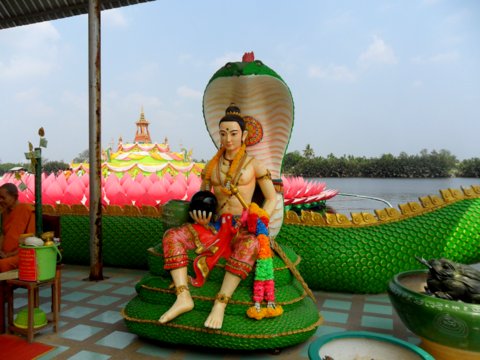
Phra Kade with Rahu The statue represents the planet Neptune or "Phra Kade" named after the Roman God of the Sea. Neptune is sitting on the serpent Rahu. In Indian mythology, Rahu is an asura or demon who swallows the Sun and Moon and caused eclipses. Lunar nodes mark the path of the Moon as it passes its ecliptic; the north node is on the path when the Moon moves from south to north and the south node is the reverse. In ancient Vedic astrology, the north node is called Rahu, the head of the serpent and the south node, Ketu, the tail. In Thai astrology, the Sun, Moon and seven planets Mars, Mercury, Jupiter, Venus, Saturn, Rahu and Ketu are represented by deities and animals as their vehicles. How Rahu came to be associated with Neptune is something beyond me. My thanks to Rungroj Nopnarathip for casting some light on this complicated subject. The centre of attraction in Wat Saman is a huge statue of Ganesha the Elephant God in a reclining position. Ganesha, the god of accomplishment, success and the destroyer of evil, is one of the five prime Hindu deities. 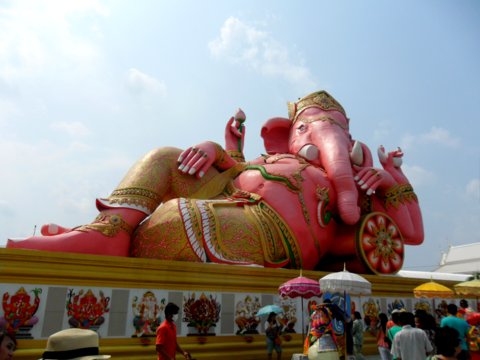
Ganesha the Elephant God The steed of Ganesha is the rat and there were a couple of statues of rats standing on their hind legs. Queues were formed up for worshippers to hug the rats. I wondered why. It was only later that I found out the reason for this practice. The worshipper hugs the rat and whispers his or her wish into the rat’s ear so that the wish can be transmitted to Ganesha. The other ear of the rat is covered so that the wish is retained. 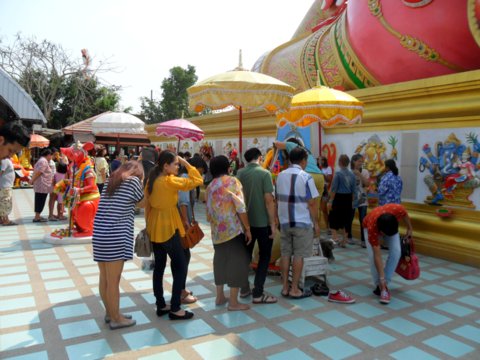
Hugging the Rat A statue of Kuan Yin the legendary Goddess of Mercy towers over the Bang Pakong as she gazes out towards the placid waters. 
Kuan Yin – the Goddess of Mercy – courtesy of Lim Siew Hwei To add to the variety of deities there is also a shrine dedicated to Brahma, one of the Trinity of Hindu Gods the other two being Vishnu the Preserver and Siva the Destroyer. 
Brahma the Creator The Three Wise Men in Chinese astrology or "fu lu shou" represent the stars in our constellation; fu – good fortune (the planet Jupiter), lu – wealth (the brightest star in the Bigger Dipper constellation), shou – longevity (the Antarctic Canopus star, the brightest star in the Southern constellation). 
Fu Lu Shou – the Three Wise Men These three statues placed side by side (fu on the viewer’s right and shou on the viewer’s left) provide for harmony, wealth and good health in the home. Here’s a cute display of a row of small statues of novice monks with alms bowls, one for each day of the week. Donors presumably put coins in their favourite day of the week, perhaps their day of birth. 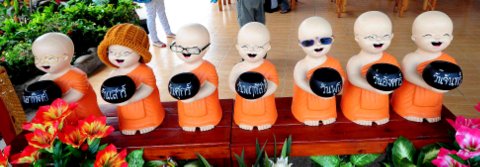
A bowl for each day of the week – courtesy of Lim Siew Hwei Several dragons adorn the temple grounds; a white dragon complete with scales line the river front while two other colourful dragons rear their heads in confrontation. Further behind, a more-photo friendly dragon accepts offerings and poses with visitors 

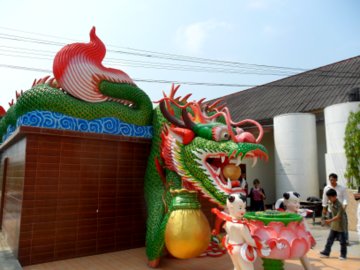
There was a carnival air as a temple fair was on that day. A floating market belonging to the temple is raising funds for the construction of a hospital. 
Restaurant on a raft On the road leading to the temple, street vendors set up stalls selling a variety of items. 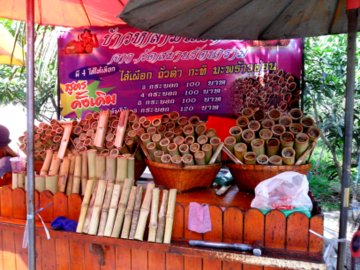
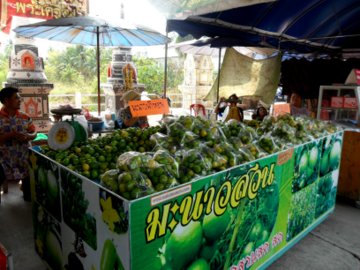
The ever-popular khao lam (left) and fresh lemons from the farm (right) Here’s a spectacular shot taken from Lotus Island looking landwards before we left. At the scheduled time, the boat arrived to take us back to Ban Mai Market and from there, the drive back to Bangkok. 
Parting shot – courtesy of Lim Siew Hwei Table of contents Map of the river boat tour View Bang Pakong River boat tour in a larger map Opening hours The Ban Mai Market is open on weekends and public holidays from 9:00 am – 5:00 pm. Fees for the river tour Boat tour: adults - 100 baht, children - 50 baht Admission to the temple is free. How to get to there By car To Chachoengsao and Ban Mai Market Take Motorway 7 or the Bang Na – Chonburi Express, Highway 3, and then turn into Highway 314. Keep going till you get to Chachoengsao town where Wat Sothon is located. Drive along Maruphong Road that runs on the west bank of Bang Pakong until you get to the bridge. Continue along the banks of the Bang Pakong till you get to Ban Mai Market. Visitors’ parking lots are opposite the market on the road that leads to Wat Thep Nimit. The boat pier is at the northern end of the market. Of course visit the market first and have your lunch before taking the boat tour. The most convenient boat is the one at departs at 1330 hours. There’s another boat at 1630 hours and that’s probably the last boat. Table of contents My thanks Thank you Lim Siew Hwei for your beautiful photo contributions. Table of contents Next month The Prachinburi National Museum – history of eastern Thailand If you enjoyed reading this e-zine, please forward it to a friend. If you received this from a friend and found it interesting, please subscribe at Bangkok Travelbug. What you think of the Bangkok Travelbug? We love to hear from you What other subscribers have said Till next month then. Eric Lim Tour Bangkok Legacies Find us on Facebook Copyright@2008-2014 Tour Bangkok Legacies All rights reserved |
| Back to Back Issues Page |
